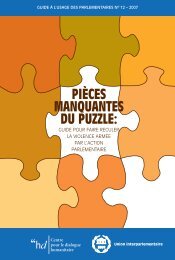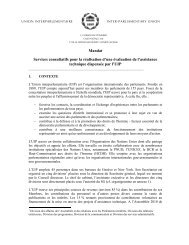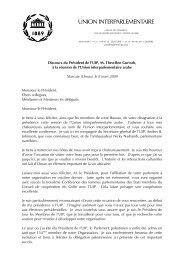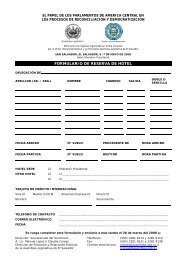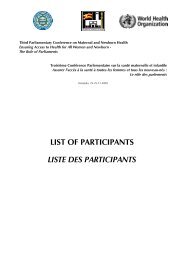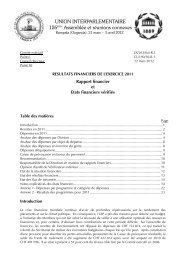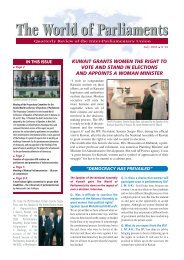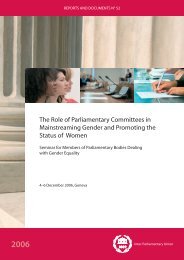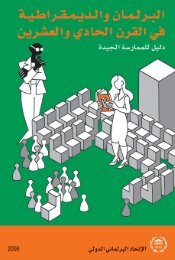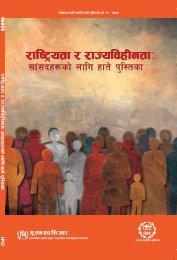MISSING PIECES - Inter-Parliamentary Union
MISSING PIECES - Inter-Parliamentary Union
MISSING PIECES - Inter-Parliamentary Union
Create successful ePaper yourself
Turn your PDF publications into a flip-book with our unique Google optimized e-Paper software.
<strong>MISSING</strong> <strong>PIECES</strong><br />
In addition, ammunition stockpiles, often stored alongside explosives,<br />
have proven to have fatal consequences for civilians if left poorly managed.<br />
In January 2002, a military ammunition storage facility caught fire in<br />
Lagos, Nigeria, setting off explosions that resulted in the death of over 1,000<br />
people. 7 In April 2003, a flare gun was reportedly used to intentionally ignite<br />
an ammunitions dump in Baghdad. The resulting explosion killed up to<br />
40 people. 8 In May 2005, a hidden ammunitions and weapons storage<br />
facility in Bashgah, Afghanistan, exploded, killing 28 and injuring more<br />
than 70. 9<br />
4. Integrated approaches<br />
Weapons collection is only one aspect of the transitional process aimed<br />
at establishing security after armed conflict. Other issues to be addressed<br />
include restructuring the armed forces, security sector reform, democratisation<br />
and transitional justice, repatriation of refugees and the internally<br />
displaced, economic recovery, and longer-term socio-economic development.<br />
All these elements are to some degree mutually dependent and vary<br />
in form across contexts. Unless some disarmament and weapons control<br />
measures are in place, the environment will often remain too insecure to<br />
pursue these other aims or they are likely to be undermined. Conversely,<br />
weapons collection efforts will often not be successful unless alternative<br />
security guarantees are also offered. Weapons are often held in response<br />
to perceptions of insecurity, and therefore weapons collection exercises will<br />
have better chances of success if linked to reforms of the security sector,<br />
for example to promote models of community policing.<br />
“. . . projects and programmes that try to persuade people to hand in<br />
their weapons only work if people feel safe and secure, and have real<br />
alternatives to violence. That is why integrating small arms control<br />
into national development planning frameworks will help to ensure<br />
that decisions are made locally, reflect national and local priorities<br />
and help donors unlock more resources“<br />
—UK statement at the UN Review Conference, 27 June 2006<br />
Lessons learned in Sierra Leone demonstrated that disarmament should<br />
be conceptualised as ‘an integral and extended process of national recovery<br />
through security-building rather than as a technical process of post-conflict<br />
weapons collection and demobilisation’ 10 . The design and implementation<br />
of small arms control efforts should also more broadly involve govern-<br />
100



